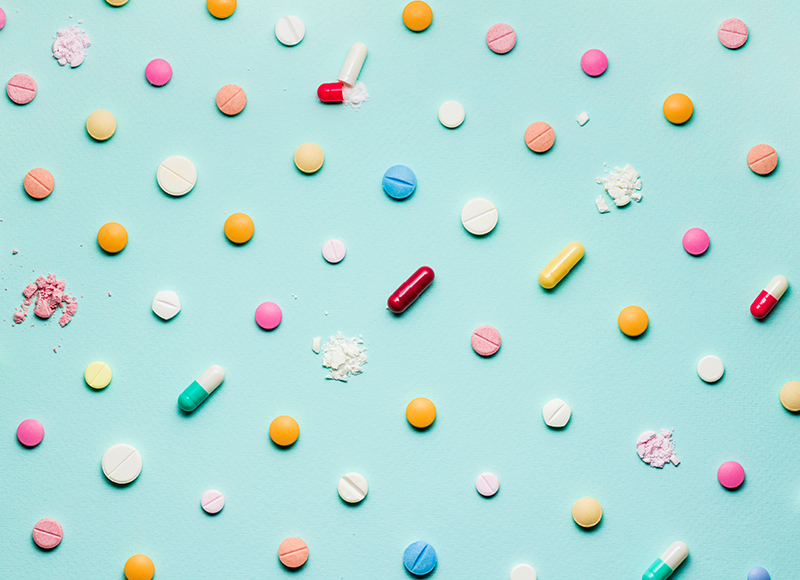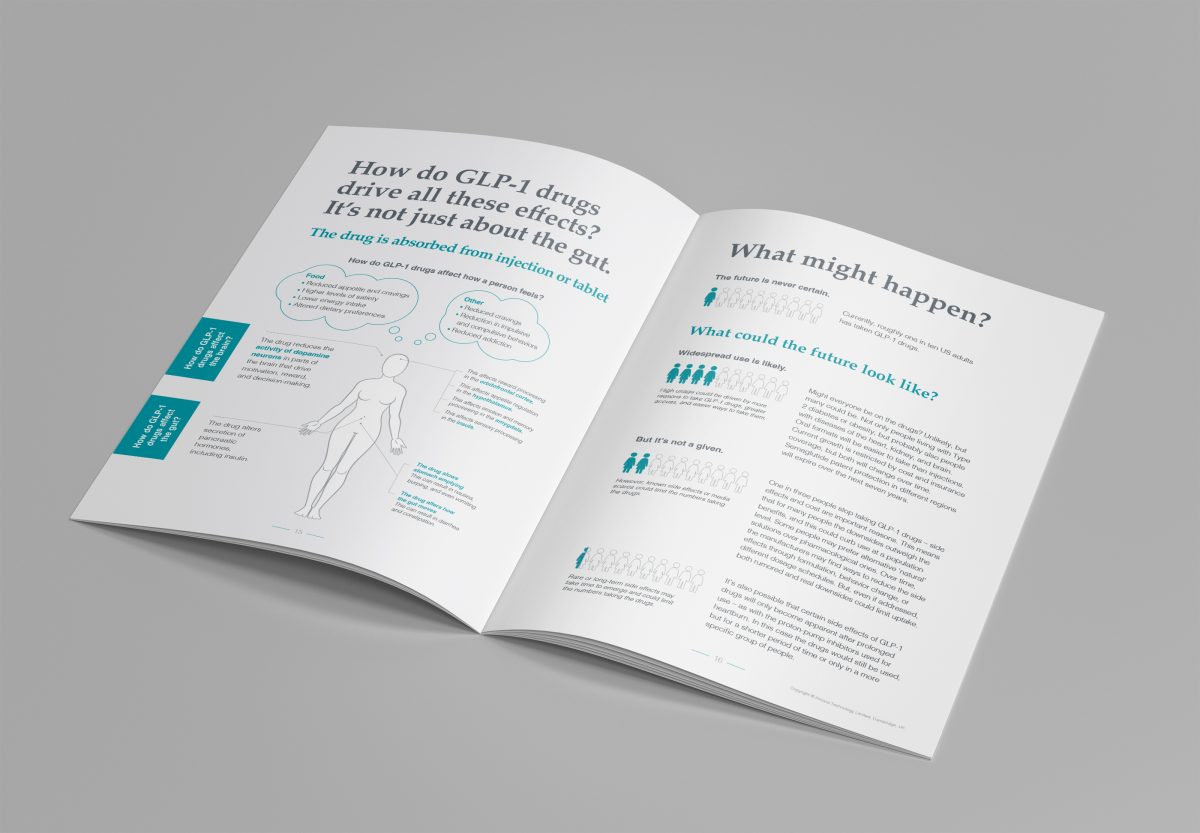Deep Read:
Radical basics: a manifesto for innovating through the extreme uncertainty of a post-COVID world
The rules for creating new solutions and for navigating this uncertainty are radically basic...... →
For general enquiries please contact us on
+44 1223 248888
enquiries2025@innoviatech.com
St Andrew's House, St Andrew's Road
Cambridge CB4 1DL United Kingdom
FIND US
How GLP-1 drugs could change your business...
It’s no surprise that many organisations are wondering how GLP-1 drugs might disrupt their business. Is yours?
This means that people are either likely to take the drugs on and off, resulting in cycles of weight gain and loss, or they are likely to take them continuously.
Currently, 1 in 20 US adults is taking GLP-1 drugs, and more than 1 in three are eligible.
In this interview Dr Guen Bradbury talks with business strategist Arron Rodrigues about how businesses can plan for a future where GLP-1 drugs have changed consumer expectations, healthcare models, and market dynamics.
We expect the following sectors to feel the effects as GLP-1 drug use becomes more widespread.

The food sector is on the front line. Walmart is already seeing the effects. On any given day, one in three US adults eats fast food, and half of calories consumed in the US come from so-called ultra-processed food. But GLP-1 drugs seem to change food preferences – people consume more water, leafy greens, and fruit, and less refined grains, soda, and processed foods. [1] What does this mean for portion sizes? Taste profiles? Food subsidies and farming? Where’s all the corn syrup going to go?

But we don’t just eat at home. People taking GLP-1 drugs don’t spend as much at fast-food chains, coffee shops, and some restaurants. [2] The hospitality sector is thinking about how it might tempt people when food and drink are less alluring. Should it too be reducing portion sizes? Creating new, less food-centric experiences to entice people out? What happens to car and gas usage if people are staying home more?

Changing appearance and expectation of appearance could affect both the apparel sector and the beauty sector. The apparel sector anticipates more demand for clothing in smaller sizes. Will fast fashion increase to cater for people who are rapidly changing shape? What clothing styles flatter body shapes after rapid weight loss?

The beauty sector is thinking about the needs of people with ‘Ozempic face’ – the effect of rapid weight loss on the face. Perhaps this will drive increased interest in skin-tightening treatments, skin hydration, or even cosmetic surgery.

We may find that people are exercising more – either because they’re told to do so by their doctor, or because they feel more confident about going to the gym. Or perhaps people may exercise less – they may ‘outsource’ their health management to the drug or may find that their motivation to exercise is reduced. Either way, the sport and exercise industry is likely to see change.

Changes in pain and gastrointestinal symptoms will affect consumer health companies. How might altered dietary patterns affect vitamin and mineral requirements?

Major changes in the prevalence of certain diseases, or the age that people are when they develop them, will certainly have effects on pharma and MedTech companies. We’re already seeing changes in bariatric surgery volumes, but what procedures are going to become more relevant? Similarly, which drugs will be needed more and which drugs less?
The effects are likely to be widespread and unpredictable. Airline providers predict that lighter passengers might significantly reduce fuel costs. The energy sector may notice changes in energy use for heating and air conditioning because people taking these drugs feel colder. Many industries are likely to be affected. Will yours?
In this interview, Dr Guen Bradbury talks with Dr Helena Rubinstein about how GLP-1 drugs could be as socially disruptive as the smartphones, and how businesses can respond.
You might be thinking “OK, lots of people might take end up taking these drugs. But it’s about food, right? They change what you want to eat, and how your body responds to the food?” And yes, that is a part of the story.
GLP-1 drugs slow stomach emptying and affect insulin sensitivity. But the big thing they do is reduce appetite. But it’s not all appetite. They don’t just reduce consumption of all foods. People’s food preferences change.
GLP-1 drugs specifically affect reward processing by reducing the activity of dopamine neurons. They specifically seem to tone down our response to the most rewarding things we encounter. In our society, the most visible effect is that they reduce our consumption of certain foods. But the effects go far beyond this. These drugs reduce not only food consumption, but also consumption of addictive substances (not only illegal drugs, but also cigarettes, alcohol, and even coffee). They may even affect how people shop.
It’s hard to know how many of your consumers are taking GLP-1 drugs unless you ask. One organisation, in a survey of their skincare consumers, found that more than 25% of survey respondents were taking these drugs.
Now, that might just be a skewed sample, but it’s plausible that many ‘target consumers’ may be taking these drugs.
Why? Because ‘target consumers’ are the people most likely to buy a product. People who binge eat and people with a higher BMI are more likely to show certain impulsive behaviours.[3] And people taking GLP-1 drugs report less impulsive and compulsive shopping.[4]
In this interview, Dr Guen Bradbury talks with Dr Eve McMahon about how medicine has been surprised by the increase in use of GLP-1 drugs, and what this means for the future.
Currently, yes. And cost is just one of the barriers to their use. But things are going to change.
These drugs are notoriously expensive but will come off initial patents everywhere by 2032. There’ll be a race to maintain protection, but generic versions will start to come in sooner than we realise.

Currently, 70% of US insurance coverage excludes GLP-1 drugs, but cost will come down and the health economics will change. At a certain price point, insurance will cover the drug for people who are most at risk of health problems.

Up until recently, many people were buying the drugs out-of-pocket from compounding pharmacies and telehealth providers because of supply issues, but now supply is stable, the FDA is phasing out off-brand GLP-1 drugs. However, the drug manufacturers may start to partner with telehealth providers to ensure access.

There are various short and long-term side effects of GLP-1 drug use. The most common are nausea and gastrointestinal problems. There are also side effects from rapid weight loss on the skin and body shape. There’s likely to be innovation against these, but we suspect that they’ll remain a barrier.

Currently, most of the drugs are injectable, which can be a barrier to their use. Oral forms require strict dosing instructions to make sure that enough gets into the body. We expect oral forms to become more common over time.

Because use of these drugs is still uncommon, and because bodyweight is so stigmatised, there is some moral judgment around their use. We expect this to become less as their use becomes more common and as societal expectations change.

It doesn’t matter what industry you’re in. You don’t want to be caught by surprise.
To help our clients, we’ve gathered the perspectives of doctors, behavioural scientists, strategists, and innovation consultants, and produced a report that’s freely available on our website.
Start a conversation: glp1@innoviatech.com

[1] Dilley, Andrew, et al. “Characteristics and food consumption for current, previous, and potential consumers of GLP-1 s.” Food Quality and Preference 129 (2025): 105507
[2] Hristakeva, Liaukonyte, Feler. “The No-Hunger Games: How GLP-1 Medication Adoption is Changing Consumer Food Demand”. SC Johnson College of Business. (2025).
[3] Meyre, D., Mohamed, S., Gray, J.C. et al. Association between impulsivity traits and body mass index at the observational and genetic epidemiology level. Sci Rep 9, 17583 (2019).
[4] Arillotta, D.; Floresta, G.; Papanui Pelletier, G.D.; Guirguis, A.; Corkery, J.M.; Martinotti, G.; Schifano, F. Exploring the Potential Impact of GLP-1 Receptor Agonists on Substance Use, Compulsive Behavior, and Libido: Insights from Social Media Using a Mixed-Methods Approach. Brain Sci. 2024, 14, 617.